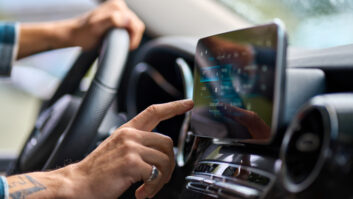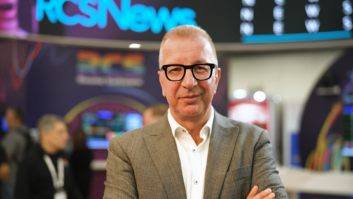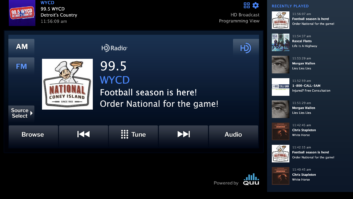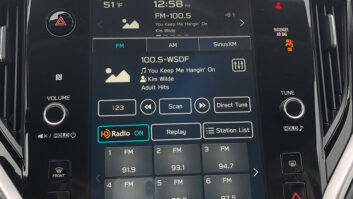While the use of RDS is now common among FM broadcasters in the U.S., not every station is taking advantage of the functionality that it provides.
A new RDS standard is on the horizon; RDS2 was just demonstrated at the 2015 meeting of the RDS forum. It�s a good time to examine the current RDS standard some, along with RDS2.�
There are many RDS encoder models available, and just as many ways to get metadata (such as �now playing� information) up to your transmitter site. We�ll take a look at some of the products that are available.
RDS AS WE HAVE COME TO KNOW IT
Inovonics 730The RDS system is the familiar way by which we have transmitted slow amounts of data over FM radio for the last 15 years or so.

Its primary characteristics are as follows:
� Data is sent by way of a 57 kHz subcarrier.
� The data rate is 1187.5 kbps, modulating the carrier by QPSK.
� The power associated with the 57 kHz carrier remains the same, even when modulated (Meaning: If you give the RDS subcarrier 5 percent injection, it maintains that level, even while it is modulated.)
For those of you who have never used subcarriers, I�ll point out some particular FCC rules you must know:
� 73.1570(2)(i) The total peak modulation may be increased 0.5 percent for each 1.0 percent subcarrier injection modulation, and
� (ii) In no event may the modulation of the carrier exceed 110 percent (82.5 kHz peak deviation).
� In other words, you must give back a little of the modulation percentage of your main program audio when you add subcarriers, and RDS is no exception.
The most familiar payloads of the RDS system are the program identification (PI), which is a unique code that identifies the radio station (and also used in the RadioDNS system); the program service (PS), which is a simple eight-character static display typically displaying a station�s name or call letters; radio text (RT), which is a 64-character line of text that can be static or dynamically associated with the program content (such as �now playing� information); Dynamic PS (DPS) which is the parsed, eight-characters-at-a-time dynamic display that some radios have; and traffic message channel (TMC), which is data that can be used by automotive navigation systems.
RDS2
The RDS2 standard is coming, but it is still in development.

From the June 15 edition of the NAB Broadcast Blog (http://tinyurl.com/pk75skx), we can glean the following information:
� RDS2 will make use of up to three additional subcarriers (along with the original 57 kHz subcarrier) that will be centered at 66.5, 71.25, and 76 kHz.
� It is proposed that the new RDS2 subcarriers will be used exclusively to transmit Open Data Application information. Previously established as part of the legacy RDS format, ODAs are used to support a variety of data services, and are the principal way that new services utilize RDS.
The most important aspect of the proposed RDS2 standard is that it will support far more data transmission capability � on the order of 10 to 20 times more than the current standard. From NAB�s Broadcast Blog: �With the completion of the successful prototype demonstration and the RDS Forum members in agreement that RDS2 should be incorporated into the Standard, it is now the task of the newly formed RDS Forum Working Group to develop the detailed specification for RDS2, and in addition to identify the obsolete sections of the existing Standards that can be eliminated.�
However, �there�s no such thing as a free lunch.� After the RDS2 standard becomes finalized, and equipment is made available, that 73.1570(2)(i) and (ii) are still going to apply. Typically, RDS subcarriers are injected at a fairly low level � not enough to make a noticeable difference to the normal programming. If you add three other subcarriers � in order to transmit more data � you�ll be obligated to turn down the main channel modulation to the point that it might be noticeable. There will be a trade-off between the overall modulation level, and the effectiveness of the data transmission of RDS2. Those of us that transmitted data subcarriers in days past have already fought this battle.
HANDLING METADATA
Jumpgate3 RDS monitorHaving the means to transmit �now playing� information, among other data, is fine � but you need some way of collecting it, and making sure it ends up in the correct place � like at your RDS encoder or streaming encoder(s). Many vendors are out there ready to provide everything necessary to make this happen.

Enco offers up PADapult, a system that allows the user to create and distribute �now playing� information along with message-casting content by sending real-time text data out to as many as 10 destinations, including RDS, your website and social media like Twitter. Because PADapult is a stand-alone application, you can use it with any automation system. Some of its other features include:
� Text data can be sent to whichever service you choose, automatically or on the fly.
� (Optional) PADLive!�s comment field allows free-form information to be sent for emergency or promotional messages
� When used with compatible automation systems, PADapult supports sending of iTunes tagging information for HD Radio
� When used with compatible Omnia or Vorsis audio processors, PADapult supports Content Adaptive Processing, allowing �on the fly� changes to processing based on audio group/types
Jump2go offers the Jumpgate data processor, which is a single device that accomplishes the following:
� Manages communications between automation systems and Jump2go�s Web-based distribution system (CORE)
� Affords station engineers the means by which they can browse at the bi-directional communications between Jumpgate�s CORE, either by PC or mobile device
� Provides both DPS and RT and RT+ for RDS
� �True iTunes tagging� (song identifications) broadcast via RDS
� Also sends data to streaming servers, social media destinations, and HD Radio PSD
� Can inject ad-insertion time-adjusted metadata into streaming media encoders
� Has message management system for creating day-parted messages for RDS
� Supports Artist Experience logos (for HD Radio) and TagStation-provided images
Deva Smartgen MiniArctic Palm is another important player in this space. Center Stage RDS is the link between the Radio Automation System, Satellite Services, and the data casting devices and services. Its basic features include:

Transmission of messages to any combination of Digital Systems, website and Internet Streaming Services For RDS: PS, DPS, RT, and RT+ tagging are supported
� Transmission of messages based on metadata toTuneIn.com; or add the (optional) CSSocial module and automatically post messages to Twitter and Facebook accounts
�� During non-automation periods, or prerecorded long play segments, the �now playing� information can also be added using the Center Stage Live�s (optional) CSLogIt. Messages can be generated �on the fly� or can come from a CSLogIt Playlist
�� Based on user definable criteria, CSRDS will automatically switch between local automation, satellite services or playlist entries; promotional, information and commercial messages will be rotated into the display or added based on events in the automation system link
�� Supports TagStation (NextRadio); Artist Experience (via HD Radio)
�� Also supports Dynamic Label Slideshow, for DAB or DRM
A well known player in this field isBroadcast Electronics, and their product is The Radio Experience. In addition to pushing messages out to RDS and HD Radio, it has the following basic functions:�
� TRE runs on a single, dedicated PC
� Interleave artist/title information with custom messages
� Link�data to audio: provide concert info, advertiser info, and more�
� Target different messages simultaneously to different destinations
� Publish to�Twitter, Facebook and music communities on the Web
� Supports tagging
� Monitors datacasting logs in real time
BE has a link to a short video (http://tinyurl.com/ofu7ybh) on the setup and configuration of their RDS system. It�s worth watching.
Audemat FMB50TagStation provides services based on your station�s metadata. (It�s essentially the �back office� of NextRadio functionality.) TagStation maintains a very well done set of tutorials (http://tinyurl.com/ns9crw6) as well.

� The TagStation service is reached via the Web and receives a notification every time you play a song, a spot or a promo from your automation system
� It then then finds (in a database) content related to the audio event and delivers the content in sync with your broadcast to mobile phones, car dashboards, and �any future connected devices�
� TagStation can also send the same content back to your playout system for delivery over HD
� TagStation enables you to enhance each audio event with an image, text and a number of interaction points
� The station can define its daily broadcast schedule and deliver an image, text and a number of interactions related to each on-air show
I�ll wrap up this article by listing the most well known manufacturers of RDS encoding gear:
�Inovonics: models 703, 720 and 730
�Deva Broadcast: many models, including the SmartGen 3.1, the SmartGen Mini and the SmartGen micro
�Jumpgate: RDS generator
�BW Broadcast: the RDS2+ and the RDS3
�Worldcast Systems: FMB-80
�Broadcast Electronics: RDI-20
A large portion of our audience expects to receive additional information about music as they hear it over the radio; it�s a consequence of the kind of functionality one gets when streaming music. In that virtual space, it�s a must-have feature. This is one of several areas where radio needs to catch up with online and streaming services.
Use this article as a basic guideline for how to get started, if the topic is completely new to you.







